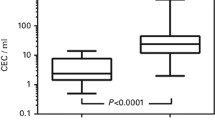Abstract
Circulating endothelial cells have been established as markers of vascular disease, such as small vessel vasculitis, acute vascular rejection in renal transplant recipients, and cyclosporine-induced endothelial damage. Enumeration of these cells by immunomagnetic isolation and acridine staining remains the gold standard but necessitates considerable experience and expenditure. A simpler test would therefore be of great utility. Hence, our aim was to develop an improved simple assay to enumerate endothelial cells in peripheral blood. We had already used various surface markers to corroborate the endothelial origin of cells. Here, we studied the enumeration of cell numbers with immunomagnetic isolation and a variety of subsequent stains, such as CD31, von Willebrand’s factor (vWF) immunocytochemistry, and Ulex europaeus lectin-1 (UEA-1). Eventually, we devised a simple protocol for enumeration using immunomagnetic isolation and a subsequent UEA-1 lectin stain. We evaluated the use of this protocol in parallel to immunomagnetic isolation and acridine counting alone in 92 renal transplant recipients who underwent renal biopsy. Recovery of various concentrations of human umbilical vein endothelial cells from blood was also studied. Immunomagnetic isolation and subsequent UEA-1 staining permits easier enumeration of circulating endothelial cells in peripheral blood. The assay is simple and easy to use, thus allowing for a more widespread use of circulating endothelial cells as a marker of vascular damage.




Similar content being viewed by others
References
Dignat-George F, Sampol J (2000) Circulating endothelial cells in vascular disorders: new insights into an old concept. Eur J Haematol 65:215–220
Woywodt A, Streiber F, de Groot K, Regelsberger H, Haller H, Haubitz M (2003) Circulating endothelial cells as markers for ANCA-associated small-vessel vasculitis. Lancet 361:206–210
Woywodt A, Schroeder M, Mengel M et al (2003) Circulating endothelial cells are a novel marker of cyclosporine-induced endothelial damage. Hypertension 41:720–723
Woywodt A, Schröder M, Gwinner W et al (2003) Elevated numbers of circulating endothelial cells in renal transplant recipients. Transplantation 76:1–4
Bouvier CA, Gaynor E, Cintron JR, Bernhardt B, Spaet T (1970) Circulating endothelium as an indication of vascular injury. Thromb Diath Haemorrh 40:163
Solovey A, Lin Y, Browne P, Choong S, Wayner E, Hebbel RP (1997) Circulating activated endothelial cells in sickle cell anemia. N Engl J Med 337:1584–1590
Mutin M, Canavy I, Blann A, Bory M, Sampol J, Dignat-George F (1999) Direct evidence of endothelial injury in acute myocardial infarction and unstable angina by demonstration of circulating endothelial cells. Blood 93:2951–2958
George F, Brouqui P, Boffa MC et al (1993) Demonstration of Rickettsia conorii-induced endothelial injury in vivo by measuring circulating endothelial cells, thrombomodulin, and von Willebrand factor in patients with Mediterranean spotted fever. Blood 82:2109–2116
Garlanda C, Dejana E (1997) Heterogeneity of endothelial cells. Specific markers. Arterioscler Thromb Vasc Biol 17:1193–1202
Risau W (1995) Differentiation of endothelium. Fed Am Soc Exp Biol J 9:926–933
Terada T, Nakanuma Y (1991) Expression of ABH blood group antigens, receptors of Ulex europaeus agglutinin I, and factor VIII-related antigen on sinusoidal endothelial cells in adenomatous hyperplasia in human cirrhotic livers. Hum Pathol 22:486–493
Stephenson TJ, Griffiths DW, Mills PM (1986) Comparison of Ulex europaeus I lectin binding and factor VIII-related antigen as markers of vascular endothelium in follicular carcinoma of the thyroid. Histopathology 10:251–260
Liu SM, Li CY (1996) Immunohistochemical study of Ulex europaeus agglutinin 1 (UEA-1) binding of megakaryocytes in bone marrow biopsy specimens: demonstration of heterogeneity in staining pattern reflecting the stages of differentiation. Hematopathol Mol Hematol 10:99–109
Acknowledgments
We are indebted to Astrid Borgnes PhD, Dynal, Norway, for technical help and to F.H. Bahlmann MD, Hannover, for helpful discussion.
Author information
Authors and Affiliations
Corresponding author
Rights and permissions
About this article
Cite this article
Woywodt, A., Goldberg, C., Scheer, J. et al. An improved assay for enumeration of circulating endothelial cells. Ann Hematol 83, 491–494 (2004). https://doi.org/10.1007/s00277-004-0878-3
Received:
Accepted:
Published:
Issue Date:
DOI: https://doi.org/10.1007/s00277-004-0878-3




